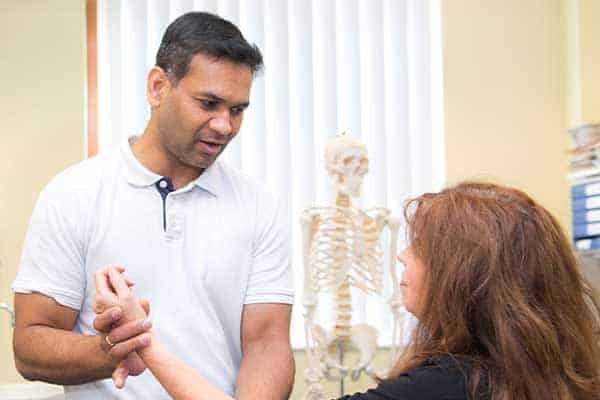Whiplash refers to the type of neck injury sustained when your head has been suddenly jolted forwards and backwards or from side to side.
It is a non-medical term that describes both the movement that causes the injury and the symptoms produced.
What causes whiplash?
Whiplash is frequently associated with traffic accidents, particularly when you have been hit from behind (can be hit from side or front too), but this type of injury can also arise from a collision in sports or a fall.
When your neck is suddenly jerked, this violent and unexpected movement can result in sprains or strains to the soft tissues such as your muscles, ligaments and tendons.
What are the symptoms of whiplash?
Although you may feel pain immediately after the injury, due to the shock that often accompanies incidents like these, it can be hours or even days before you develop the symptoms of whiplash.
For most people:
- The pain is felt in your neck, upper back and shoulder area. It is also common to feel pain and stiffness in middle and low back region.
- The pain causes muscle spasms that in turn lead to reduced range of movement.
- It is a dull, aching pain that may become sharp when you move.
- You may also experience headaches.
Some people may experience associated disorders that include:
- Heaviness or tingling in your arms
- Dizziness
- Ringing in your ears
- Fatigue
- Poor concentration or memory
- Sleeping difficulties
How is whiplash diagnosed?
You are advised to get checked out at your GP or local hospital after any traumatic incident.
If your doctor diagnoses whiplash-related injuries, do not be alarmed. In most cases of whiplash there is minimal structural damage to the neck and the effects are not lasting.
What are the treatment options for whiplash?
Whiplash can be treated with a combination of medications, pain management and exercises. Self-management is normally all that is required.
The first thing to remember is that your neck and your spine are strong, stable structures and you will not damage them by moving. Being afraid to move is a natural reaction to pain but it can make the problem worse or stop it from resolving itself.
It is very important to manage the pain, right from the start of your symptoms, as this will help you ease back into your normal daily activities and rebuild the health of your neck. Talk to your GP or pharmacist about suitable pain medication.
You could also use a mixture of warmth and cold. For the first few days, applying an ice pack may be best as this can help give short term relief from the pain and limit the inflammation. (Do not put ice directly next to skin as it may cause ice burn. Wrap it in a damp tea towel.) After the healing phase has begun, applying warmth with a heat pack or hot water bottle can help to relax tension in your muscles.
Controlling pain is also important for getting a good night’s sleep, which can be an important factor in your recovery.
Research indicates that you are much more likely to make a quick recovery if you avoid the urge to rest your neck for long periods of time. For this reason we strongly advise against wearing soft collars, which restrict normal movement.
Initially in painful phase try small frequent repetitions of the movements of the neck in the pain free range. As movement becomes easier you can try simple stretching, mobility and strength training exercises to help maintain the health of your neck. Choose the most comfortable exercise for you and build up slowly through the others, avoiding anything that makes your symptoms get worse.
If symptoms do not begin to ease within a few days, your doctor might suggest Physiotherapy.
What is the prognosis for whiplash?
Most people with whiplash injuries will get much better within a few weeks. It may take up to three months to fully recover.
If you have not recovered after about 12 weeks, your doctor might suggest a more detailed examination.
While serious injury or damage from whiplash is uncommon, you should consult your GP or local hospital if:
- You have been unconscious or are having blackouts.
- You have disturbed vision or persistent dizziness.
- You have difficulty swallowing or speaking
- You have severe muscle spasm or your neck is in an abnormal position.
- You have persistent pins & needles, numbness or weakness in your arms or legs.
- You have any difficulty with your balance or with walking.
How can I prevent recurrence of whiplash?
Since whiplash is typically caused by a traumatic event, there is no reason for it to reoccur. However, some of the injuries and their symptoms may persist.
The best way to prevent the pain and stiffness coming back is to continue to exercise.
Avoid keeping your neck in the same position for a long time. Maintain a good posture and also remember to change your position regularly.
Use a firm mattress to sleep on and try to ensure that your head is at the same height as your body.
Recommended exercises (click to expand):
Neck flexion, extension, sidebending and rotation
- Sit up straight with your shoulders back and down, looking straight ahead.
- Tilt your head to look down towards the floor.
- Tilt your head to look up towards the ceiling.
- Turn your head to look over your right shoulder.
- Turn your head to look over your left shoulder.
- Move your right ear towards your right shoulder.
- Move your left ear towards your left shoulder.
- Keep your shoulders down at all times.
Towel rotation
- Sit in an upright chair with a short rolled-up towel behind your neck and the ends on your chest.
- Take the left end of the towel in your right hand and the right end in your left.
- Hold your hands up in front of your neck (now your hands are not crossed over but the towel ends are).
- Rotate your head to the right while moving your right hand in the same direction, pulling the towel tight.
- Gently turn your head and right hand back and forth to the right. Your left hand should stay still.
- Repeat on the other side.
Isometric neck
- Sit on an upright chair or stool, looking straight ahead.
- Place the palm of one hand against your forehead, then gently push your head against your hand and hold.
- Place your hand on the back of your head, push your head against your hand and hold.
- Place your hand on the side of your head, gently push your head against your hand and hold.
- Place your other hand on the other side of your head, gently push your head against your hand and hold.
Cat camel
- Kneel on all fours with your hands below your shoulders and your knees below your hips. Find a neutral position for your spine and head, looking down between your hands.
- Sink your back down towards the floor, lift your head up and push your tailbone out, making a downward-curved saddle shape with your spine like a cat stretching.
- Hold this position.
- Now arch your back up in the opposite direction by tucking your head and tailbone in and pulling your belly button in towards your spine, making a camel’s hump with your spine.
- Hold this position and then repeat.





